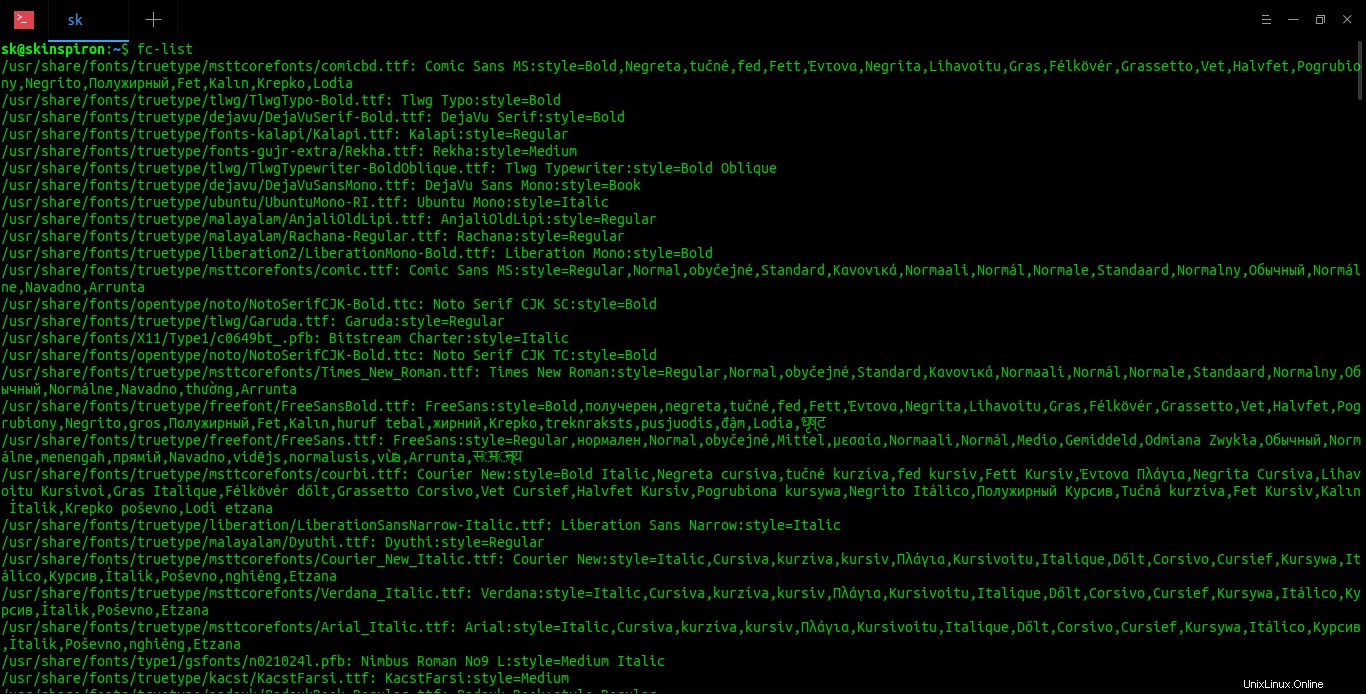¿Quieres saber qué fuentes están instaladas en tu sistema Linux? ¡Bueno! Conozco una forma rápida de encontrar todas las fuentes instaladas en su sistema Linux desde la línea de comandos. La fc-list El comando te ayuda a enumerar todas las fuentes y estilos disponibles en el sistema para las aplicaciones que usan fontconfig .
Usando fc-list , también podemos averiguar si una fuente de idioma en particular está instalada o no. En este breve tutorial, déjame mostrarte cómo enumerar todas las fuentes instaladas y también cómo enumerar las fuentes instaladas para un idioma en particular en sistemas Linux y similares a Unix.
Busca todas las fuentes instaladas desde la línea de comandos en Linux
Para enumerar todas las fuentes instaladas que están disponibles en su sistema Linux, simplemente ejecute:
$ fc-list
Salida de muestra:
/usr/share/fonts/TTF/Merriweather-Black.ttf: Merriweather,Merriweather Black:style=Black,Regular /usr/share/fonts/noto/NotoSansTaiLe-Regular.ttf: Noto Sans Tai Le:style=Regular /usr/share/fonts/noto/NotoSansGothic-Regular.ttf: Noto Sans Gothic:style=Regular /usr/share/fonts/TTF/akruti1b.ttf: AkrutiTml1:style=Bold /usr/share/fonts/mathjax/HTML-CSS/Neo-Euler/woff/NeoEulerMathJax_Normal-Regular.woff: Neo Euler,Neo Euler MathJax Normal:style=Medium,Regular [...]

Para enumerar una fuente en particular, diga "DejaVu Sans" , esté instalado o no, ejecute el siguiente comando:
$ fc-list | grep "DejaVu Sans"
Salida de muestra:
/usr/share/fonts/TTF/DejaVuSansCondensed.ttf: DejaVu Sans,DejaVu Sans Condensed:style=Condensed,Book /usr/share/fonts/TTF/DejaVuSans-BoldOblique.ttf: DejaVu Sans:style=Bold Oblique /usr/share/fonts/TTF/DejaVuSansMono.ttf: DejaVu Sans Mono:style=Book /usr/share/fonts/TTF/DejaVuSansCondensed-Oblique.ttf: DejaVu Sans,DejaVu Sans Condensed:style=Condensed Oblique,Oblique /usr/share/fonts/TTF/DejaVuSansMono-Oblique.ttf: DejaVu Sans Mono:style=Oblique /usr/share/fonts/TTF/DejaVuSansCondensed-BoldOblique.ttf: DejaVu Sans,DejaVu Sans Condensed:style=Condensed Bold Oblique,Bold Oblique /usr/share/fonts/TTF/DejaVuSans-ExtraLight.ttf: DejaVu Sans,DejaVu Sans Light:style=ExtraLight /usr/share/fonts/TTF/DejaVuSans-Oblique.ttf: DejaVu Sans:style=Oblique /usr/share/fonts/TTF/DejaVuSansMono-Bold.ttf: DejaVu Sans Mono:style=Bold /usr/share/fonts/TTF/DejaVuSansCondensed-Bold.ttf: DejaVu Sans,DejaVu Sans Condensed:style=Condensed Bold,Bold /usr/share/fonts/TTF/DejaVuSansMono-BoldOblique.ttf: DejaVu Sans Mono:style=Bold Oblique /usr/share/fonts/TTF/DejaVuSans.ttf: DejaVu Sans:style=Book /usr/share/fonts/TTF/DejaVuSans-Bold.ttf: DejaVu Sans:style=Bold
Si desea enumerar todas las fuentes truetype en su disco, puede usar el find dominio. Tenga en cuenta que llevará algún tiempo completarlo según el tamaño de su disco duro y la cantidad de fuentes disponibles en su sistema.
$ sudo find / -type f -name "*.ttf"
fc-list no se encuentra en su sistema, instale fontconfig paquete. Por ejemplo, para instalar fontconfig en Ubuntu y sus derivados, ejecute:
$ sudo apt-get install fontconfig
Recommended Download - Free eBook: "Learn Linux in just 5 Days"
Buscar fuentes instaladas para un idioma en particular
La fc-list El comando también nos permite enumerar las fuentes instaladas para un idioma en particular.
Para enumerar la fuente instalada para un idioma específico, debe mencionar el código de idioma correcto con fc-list comando como se muestra a continuación.
A la lista de fuentes instaladas para Tamil idioma, ejecute el siguiente comando:
$ fc-list :lang=ta
Salida de muestra:
/usr/share/fonts/TTF/akruti1b.ttf: AkrutiTml1:style=Bold /usr/share/fonts/TTF/akruti2b.ttf: AkrutiTml2:style=Bold /usr/share/fonts/TTF/akruti1.ttf: AkrutiTml1:style=Normal /usr/share/fonts/TTF/akruti2.ttf: AkrutiTml2:style=Normal /usr/share/fonts/noto/NotoSerifTamil-Regular.ttf: Noto Serif Tamil:style=Regular /usr/share/fonts/noto/NotoSansTamil-Bold.ttf: Noto Sans Tamil:style=Bold /usr/share/fonts/noto/NotoSansTamilUI-Regular.ttf: Noto Sans Tamil UI:style=Regular /usr/share/fonts/TTF/DroidSansTamil-Bold.ttf: Droid Sans Tamil:style=Bold /usr/share/fonts/TTF/TAMu_Kadampari.ttf: TAMu_Kadambri:style=Regular /usr/share/fonts/TTF/TAMu_Kalyani.ttf: TAMu_Kalyani:style=Regular /usr/share/fonts/TTF/DroidSansTamil-Regular.ttf: Droid Sans Tamil:style=Regular /usr/share/fonts/noto/NotoSansTamil-Regular.ttf: Noto Sans Tamil:style=Regular /usr/share/fonts/TTF/TSCu_Comic.ttf: TSCu_Comic:style=Normal /usr/share/fonts/TTF/TAMu_Maduram.ttf: TAMu_Maduram:style=Normal /usr/share/fonts/noto/NotoSansTamilUI-Bold.ttf: Noto Sans Tamil UI:style=Bold /usr/share/fonts/TTF/TSCu_Paranar.ttf: TSCu_Paranar:style=Regular /usr/share/fonts/TTF/TSCu_Times.ttf: TSCu_Times:style=Normal /usr/share/fonts/TTF/TSCu_paranarb.ttf: TSCu_Paranar:style=Bold /usr/share/fonts/noto/NotoSerifTamil-Bold.ttf: Noto Serif Tamil:style=Bold
O bien, use el siguiente comando para enumerar las fuentes Tamil instaladas o las fuentes compatibles con Glifo tamil :
$ fc-list -f '%{file}\n' :lang=ta Para obtener más detalles, consulte las páginas man.
$ man fc-list
Lectura sugerida:
- Cómo instalar las fuentes web de Google en Ubuntu
- Font Finder:busca e instala fácilmente Google Web Fonts en Linux
- Instalar fuentes de Microsoft Windows en Ubuntu 18.04 LTS
- Cómo cambiar el tipo y tamaño de fuente de la consola Linux
Conclusión
En esta breve guía, discutimos cómo enumerar todas las fuentes instaladas y cómo enumerar las fuentes instaladas para un idioma específico usando fc-list Comando en sistemas Linux y Unix. Como puede ver, encontrar las fuentes instaladas en un sistema Linux no es tan difícil.